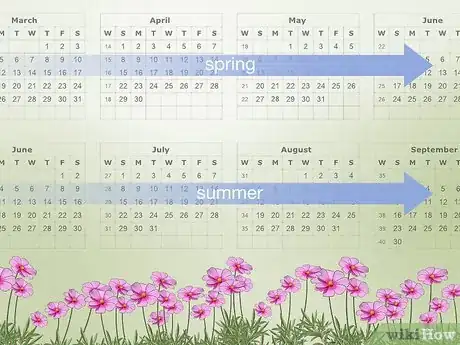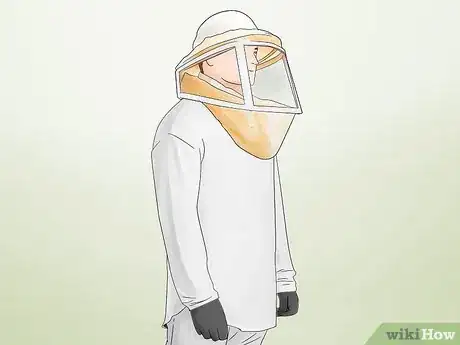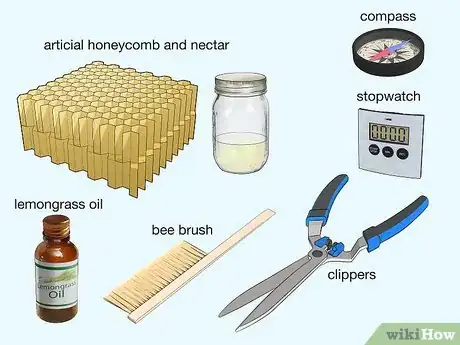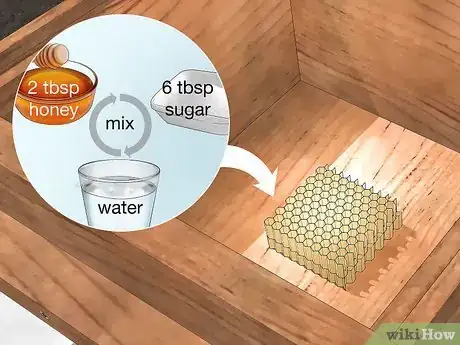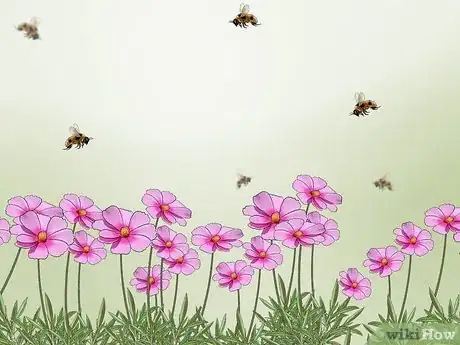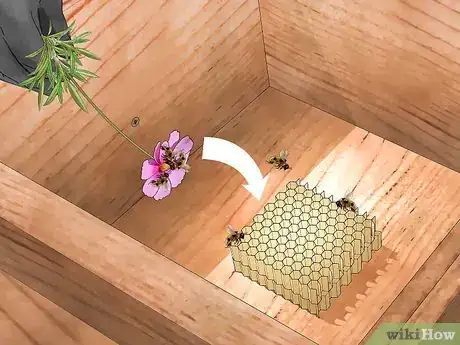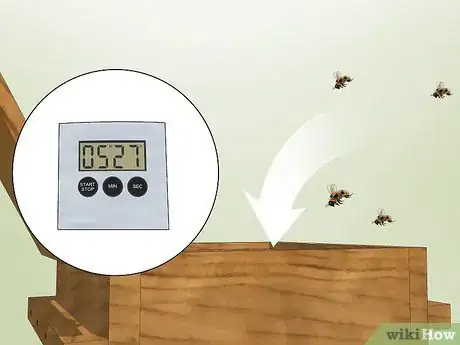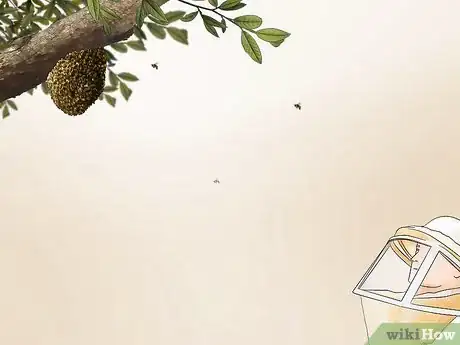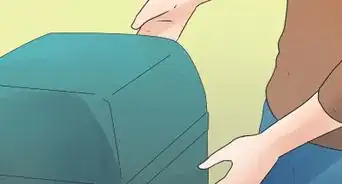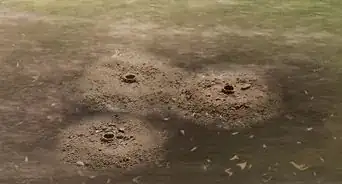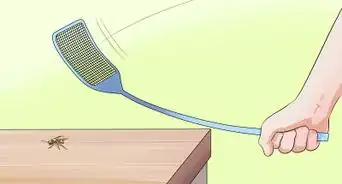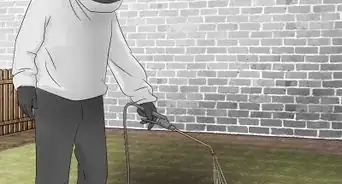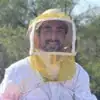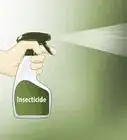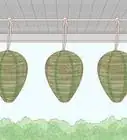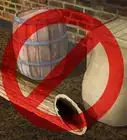This article was co-authored by Steve Downs and by wikiHow staff writer, Sophia Latorre. Steve Downs is a Live Honey Bee Removal Specialist, Honey bee Preservationist, and the Owner of Beecasso Live Bee Removal Inc, a licensed bee removal and relocation business based in the Los Angeles, California metro area. Steve has over 20 years of humane bee capturing and bee removal experience for both commercial and residential locations. Working with beekeepers, agriculturalists, and bee hobbyists, Steve sets up bee hives throughout the Los Angeles area and promotes the survival of bees. He has a passion for honeybee preservation and has created his own Beecasso sanctuary where rescued bee hives are relocated and preserved.
This article has been viewed 32,082 times.
Following bees to their hive is an age-old tradition as well as an exciting endeavor. Whether you’re looking to capture bees for your own hive, or simply want to find a wild bee colony, you can do so with a little time and effort.
Steps
Finding Bees
-
1Track bees in the spring and summer. You’ll find the most bees when the weather is warm and the flowers are blooming. Rainfall increases the amount of flowers, and therefore nectar, available to the bees, so plan to track bees on a warm day after a recent rainfall.[1]
-
2Wear protective clothing. To protect yourself from stings, wear long sleeves and pants. Light-colored clothing is best to deter insects and keep you from overheating. Put on gloves and a hat with a veil designed for bee-keeping. Wear sturdy boots or shoes so you can easily navigate the terrain when following the bees.[2]Advertisement
-
3Gather your supplies. You’ll need a bee box, artificial nectar and honeycomb (which you can get from beekeepers), and a stopwatch. You may also want a compass, a GPS tool, lemongrass oil, clippers (to cut branches), and a bee brush.
- You can make a bee box or buy one from a beekeeping supply store or online. Though most bee boxes are made from wood and mesh screens, you can use a cardboard file box in a pinch.
-
4Put bee food in a bee box. Make artificial nectar by combining 2 tablespoons (30 ml) of honey, 6 tablespoons (89 ml) of sugar, and just enough water to completely dissolve the honey and sugar. Then, simply spoon it into a honey comb and place the filled honeycomb in the bottom of the bee box.[3]
-
5Find a natural swarm. Take the bee box and your other supplies with you as you try to find a natural swarm of bees feeding on flowers in the area. Bees particularly like cosmos, sunflowers, lavender, bluebells, clematis, rosemary, poppies, and snapdragons, so look out for these flowers.[4]
-
6Attract bees with nectar, if necessary. If you can’t find a swarm, lure the bees in with a bowl of artificial nectar. Place it in an area where you’ve seen swarms of bees before, such as in a garden or field of wildflowers. You can also put lemongrass oil directly in the bee box to lure bees inside.[5]
Tracking Bees
-
1Capture a cluster of bees in the box. If the bees are on a large branch, gently shake the branch to get the bees to drop into the box. If the bees are clustered on small shrubs or flower stems, clip the vegetation and place it, with the bees, in the box. If the bees are swarming on a fence or wall, use a bee brush to sweep them into the box. Close the lid when you’ve got them inside.[6]
- Be sure to keep your gloves, veil, and other protective gear on in case the bees get agitated!
-
2Release the bees when they stop buzzing. When the bees stop buzzing it means they’re eating the food you provided. Usually, when you open the box the bees will fly out immediately, but if they don’t, wait a few minutes for them to finish eating. The bees will likely be confused and fly in circles at first. Then, they’ll head straight for their colony.[7]
-
3Mark how long it takes the bees to come back to the box. Leave the box open so the bees can return for more food. When the bees leave the box, they’ll head to their hive. Use a stopwatch to track how long it takes the bees to make it to their hive and back to the box. Bees generally travel less than a mile from their hive to look for food.[8]
- If the bees return in 3 minutes or less, the hive is likely less than 1⁄4 mile (0.40 km) away.
- If the bees return in 5-10 minutes, the hive is probably 1⁄2 mile (0.80 km) away.
- If the bees return in 10-20 minutes, the hive is up to 1 mile (1.6 km) away.
-
4Follow the bee line to their hive. Once the bees return for more food, you’ll know how far away their hive is. On their second or third trip, follow the bee line to the hive. Keep a close eye on the bees so you know which direction to travel. You may want to use a compass to ensure you are heading in the right direction. You can measure the distance with GPS, such as on your phone, if you’d like.[9]
-
5Look for their hive in a tree or other sheltered place. Keep watching the bees to ensure they are traveling in the same direction you are. As you follow the bees, inspect each tree that you pass, looking for holes or cavities that could hold a hive. Some hives can be found in fallen logs or even on the ground, as well. Listen for buzzing to direct you to the right spot.[10]
- If you lose track of the bees, return to the box and wait for a bee to feed on the nectar you provided. Then, try again to follow the bee to its hive.
Expert Q&A
-
QuestionWill a bee lead you back to its hive?
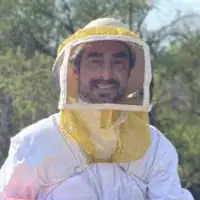 Steve DownsSteve Downs is a Live Honey Bee Removal Specialist, Honey bee Preservationist, and the Owner of Beecasso Live Bee Removal Inc, a licensed bee removal and relocation business based in the Los Angeles, California metro area. Steve has over 20 years of humane bee capturing and bee removal experience for both commercial and residential locations. Working with beekeepers, agriculturalists, and bee hobbyists, Steve sets up bee hives throughout the Los Angeles area and promotes the survival of bees. He has a passion for honeybee preservation and has created his own Beecasso sanctuary where rescued bee hives are relocated and preserved.
Steve DownsSteve Downs is a Live Honey Bee Removal Specialist, Honey bee Preservationist, and the Owner of Beecasso Live Bee Removal Inc, a licensed bee removal and relocation business based in the Los Angeles, California metro area. Steve has over 20 years of humane bee capturing and bee removal experience for both commercial and residential locations. Working with beekeepers, agriculturalists, and bee hobbyists, Steve sets up bee hives throughout the Los Angeles area and promotes the survival of bees. He has a passion for honeybee preservation and has created his own Beecasso sanctuary where rescued bee hives are relocated and preserved.
Live Bee Removal Specialist If you notice any bees on your property, you can attempt to follow them as they fly back to their hive to see where they are going. However, this only works sometimes.
If you notice any bees on your property, you can attempt to follow them as they fly back to their hive to see where they are going. However, this only works sometimes.
Things You’ll Need
- Long-sleeved shirt and pants
- Sturdy shoes or boots
- Gloves
- Hat with veil
- Honeycomb
- Artificial nectar
- Bee box
- Stopwatch
- Compass
- GPS tool (optional)
- Lemongrass oil (optional)
- Clippers (optional)
- Bee brush (optional)
References
- ↑ http://beekeepinglikeagirl.com/how-to-lure-a-swarm-of-bees/
- ↑ https://thelibrary.org/lochist/periodicals/bittersweet/wi80d.htm
- ↑ http://northernwoodlands.org/articles/article/bee-lining-the-oldtimers-way-to-find-wild-beehives
- ↑ http://honeylove.org/top-30-flowers-for-bees/
- ↑ https://beebuilt.com/pages/how-to-catch-a-swarm
- ↑ https://beebuilt.com/pages/how-to-catch-a-swarm
- ↑ http://northernwoodlands.org/articles/article/bee-lining-the-oldtimers-way-to-find-wild-beehives
- ↑ http://northernwoodlands.org/articles/article/bee-lining-the-oldtimers-way-to-find-wild-beehives
- ↑ http://northernwoodlands.org/articles/article/bee-lining-the-oldtimers-way-to-find-wild-beehives
